THE ODEON ISLEWORTH
DIDN’T THIS BUILDING USED TO BE A CINEMA?
PART NINE: THIS DID USED TO BE AN ODEON!!!
I waited at the bus stop along with a few other people for the Hounslow bus and soon the H 37 glided up and swooshed to a stop. The door sprung open and in we got. Few seem to use money anymore on a bus and we each took our turn to bring our Oyster Cards or Freedom Passes to the yellow disc, which allowed our trips to be noted and a suitable amount to be removed from our respective balance. This was performed under the watchful gaze of the driver. Once accounts had been rendered we shot off again and the bus rocked as if we were at sea.
 Oyster and Freedom Cards are now the methods of choice to pay for a ride on Transport of London vehicles.
Oyster and Freedom Cards are now the methods of choice to pay for a ride on Transport of London vehicles.
Top Row, Left: The lady who sold me my Oyster Card, which is sold with a wallet (Centre Row, Middle)
I cannot get used to the new numbering of the bus routes in London. How on earth does one arrive at a system whereby the bus route is called H 37? I assumed at first that the H meant Hounslow, but it still bears this letter even when the bus is travelling towards Richmond! Better to accept the fanciful ideas of Transport for London and delve no further into the minds of those responsible. Better to sit and look out of the window and watch the houses and sites of Twickenham and environs roll by.
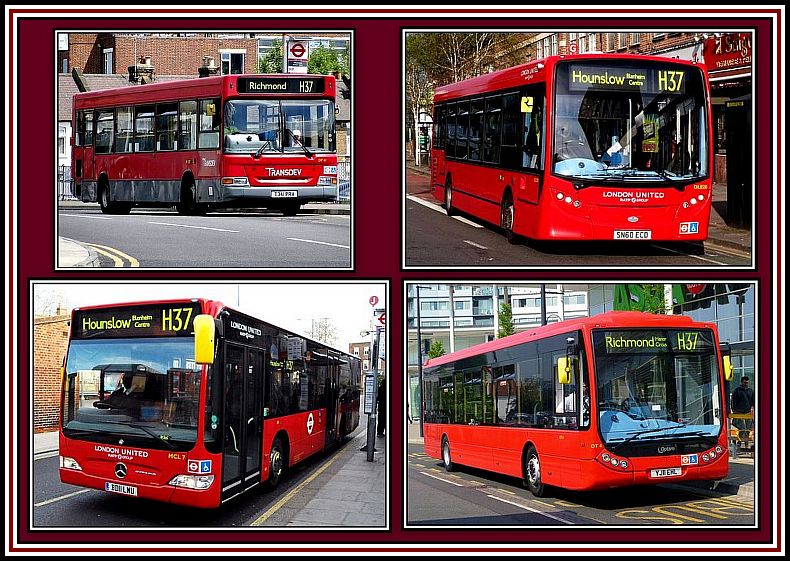 Various Bus Types used on Route H 37
Various Bus Types used on Route H 37
We were soon racing along the Twickenham Road and coming into Isleworth where we squeeched to a half at the Isleworth War Memorial. The War Memorial is located close to Our Lady of Sorrows and St. Bridget’s Roman Catholic Church and has a clock face on all sides. Although, according to a number of local newspaper articles, the design of the memorial was still under discussion in January 1922, a final decision was evidently made soon after and it was unveiled in June of that year.
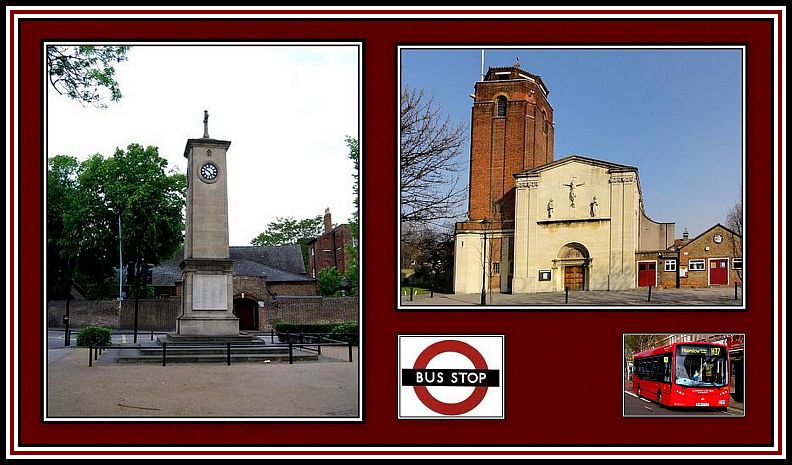 Isleworth War Memorial (Left) & Our Lady of Sorrows & St. Bridget’s Roman Catholic Church (Upper Right)
Isleworth War Memorial (Left) & Our Lady of Sorrows & St. Bridget’s Roman Catholic Church (Upper Right)
The bus turned and swayed on until Isleworth Train Station, which was the first permanent station in Isleworth. Prior to its construction, a temporary station had been built to the east, about 400 or so yards from the current site. The temporary station, opened in August 1849 and named Hounslow Station, and allowed the train service to operate until the bridges, embankment and station buildings of the permanent station were built. Following this, the temporary station’s name was changed to Smallberry Green. The present station opened in February 1850 and was named Isleworth Station, but in 1855 its name was changed to Spring Grove & Isleworth only to be returned to Isleworth in August 1911.
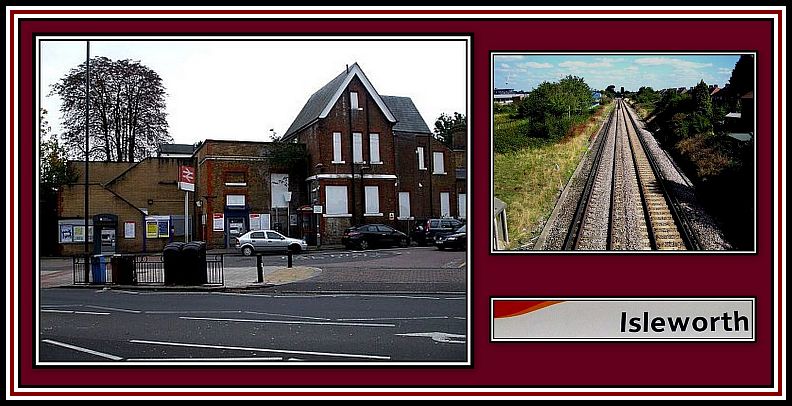 Isleworth Train Station showing the line to Hounslow
Isleworth Train Station showing the line to Hounslow
A new passenger got on the bus at the station and came and sat next to me, causing me to move over a lot to allow her the full half of the seat. As a result, I did not notice the bus’ progression and only noticed my surroundings once we were turning on to the London Road.
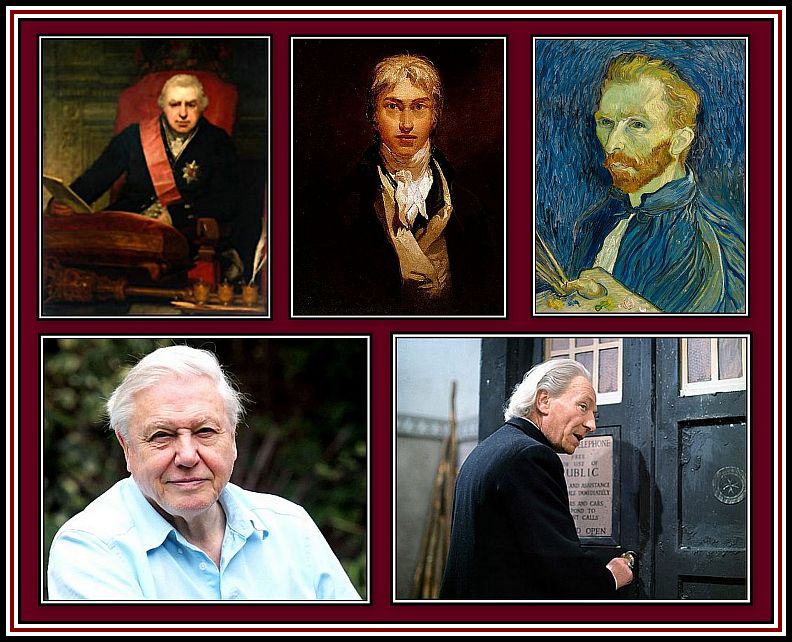 Who lived in Isleworth?
Who lived in Isleworth?
Top Left: Sir Joseph Banks, bontanist and traveller on H.M.S. Endeavour
Top Middle: William Turner
Top Right: Vincent van Gogh lived here in 1873 while working for an art dealer in London
Bottom Left: David Attenborough was born here and
Bottom Right: William Hartnell, the first Dr. Who, seen here with The Tardis
 The Tardis seen here during its trip to Glasgow in 2009
The Tardis seen here during its trip to Glasgow in 2009
As the bus raced along, it suddenly hit me! We were on the London Road and we were in Isleworth! And then, there on the right, just up the road a short way was the Odeon Isleworth!
I could not believe my eyes. Without thinking, I immediately reached out and pressed the button and the bus slammed to a halt much to the grumblings of the driver and passengers. Apparently I ought to have rung it earlier. I paid no attention to the murmurings of my fellow passengers. I was far too excited. I sprang from my seat and quickly jumped from the bus!
There it was – that glorious building! The Odeon was still there! Evidently it had survived the fate that had befallen so many cinemas and had not been demolished. I stood there and admired the building for although not demolished, it had nonetheless changed, but in spite of this, it was still The Odeon!
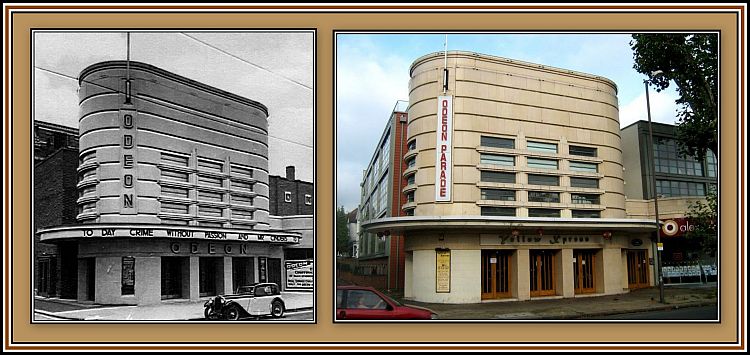 The Odeon Isleworth as it was in 1935 (Left) ……. and as it is now (Right)
The Odeon Isleworth as it was in 1935 (Left) ……. and as it is now (Right)
I could not believe my good fortune. Quite by chance I had come to Isleworth that day and quite by chance I had discovered the old Odeon once more and proving that it is better to travel hopefully and well.
I stood there looking at the building, and while I did, an old woman out walking, seeing me lost in my own thoughts, stopped and asked me if I was lost. I said no and told her that I was admiring the old Odeon. She smiled and said that she remembered it as a cinema and had gone there many times with her husband. I asked her if she liked how it looked now and she said that it still had a certain charm. We chatted and I told her how I had found the building in 1956, quite by chance, while in the area looking at the trolleybuses. After chatting further for a while, we bade each other good-bye and I crossed the street to examine the Odeon further.
I later learned that with the closure of the Odeon Isleworth as a cinema in 1957, the new owners removed the interior décor and turned it into a film studio for the making of advertisements. Although the building was renamed Isleworth Studios, the original Odeon sign remained on display on an external side wall where it was to stay until 1993.
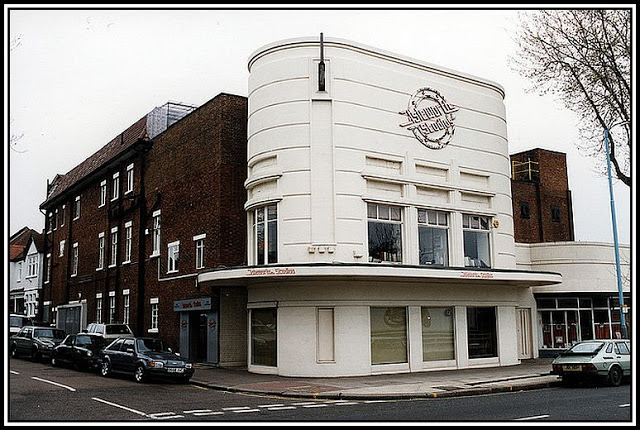 The building as a film sudio; note the ‘O-N’ of the word ODEON on the right.
The building as a film sudio; note the ‘O-N’ of the word ODEON on the right.
In 1999, the building was sold to Equator Films and continued to be used as a studio. Howver with its subsequent sale to Spring Grove Investments in 2001, it ceased to be used as a studio. In May 2002, as the auditorium was of no further use, it was demolished. Fortunately the front entrance block including the façade was retained along with the adjacent parade of shops and were restored to original design and bore the name, Odeon Parade. Where once stood the auditorium, a number of apartments were built and arranged around a central courtyard. The now-restored one-time entrance of the cinema became skillfully incorporated into the new design as an entrance to the apartments.
The façade of the cinema had been beautifully restored and looked majestic. The shops were also restored although one was vacant during my visit. Upon closer inspection of the old box office area of the cinema had now taken on a completely new function. It had become of all things a Chinese Restaurant! I looked inside, but could not go in as they were on the verge of closing. Obviously it would be necessary to return, but would this be after another fifty years!
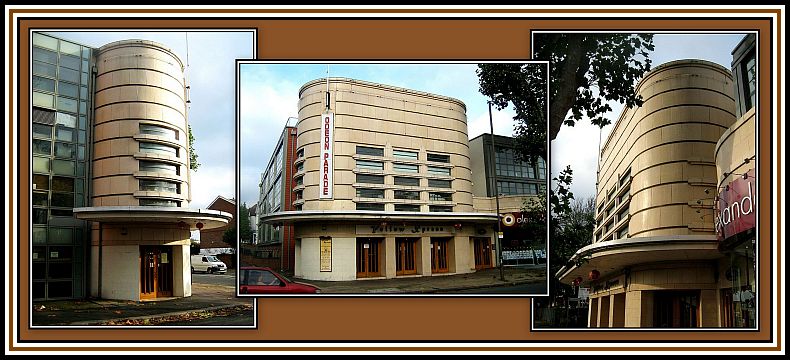 A beautiful building from any side …….
A beautiful building from any side …….
I spent a long time looking at the building, but eventually it was time to leave as I was expected elsewhere and needed to get back to Central London. During my journey back, I could not get over my luck at finding the old Odeon and being able to see it in its restored glory.
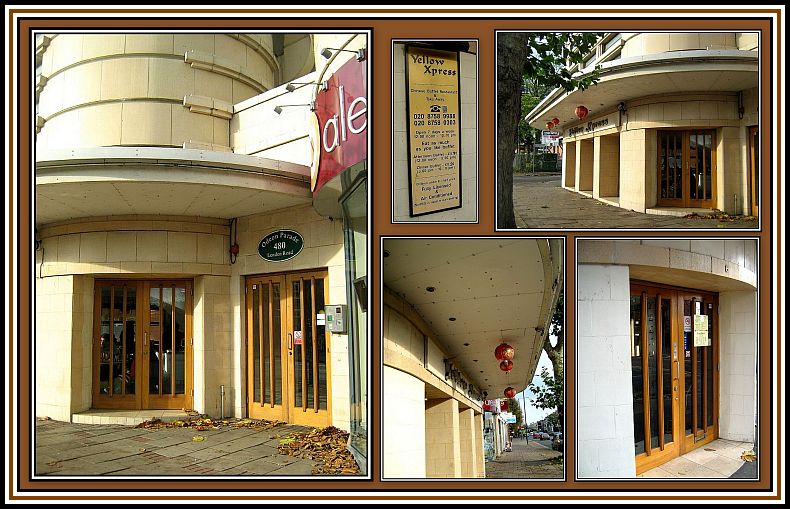 ……. and remarkable from any angle
……. and remarkable from any angle
There was little doubt about it, finding the Odeon and seeing that it had not succumb to the wrecker’s ball was going to be the highlight of my trip. The only thing missing and which would have made it even better was to find trolleybuses rumbling along the street once again.
Still, alas you can’t have everything, can you? As Bette Davis said in Now Voyager ……….. Oh Jerry, don’t let’s ask for the moon. We have the stars!
——oooOOOooo——
Footnote: While writing this piece, thanks to Kenneth Henderson in Melbourne, I learned that there had been another film studio in Isleworth, the Worton Hall Studios. Worton Hall was a country house built in 1783 and rebuilt in the early 19th Century and then converted into film studios in 1913. In 1936, Alexander Korda produced H.G. Wells’ The Shape of Things to Come there and in 1948, The Third Man began its shooting here and, shortly before the studios closed in 1951, part of The African Queen was filmed here.
——oooOOOooo——
Click here to return to PART EIGHT: SURPRISING RICHMOND
——oooOOOooo——
Click here to return to THE ODEON ISLEWORTH Home Page
——oooOOOooo——
Click here to return to the TABLE OF CONTENTS
——oooOOOooo——
4 thoughts on “PART NINE: WAIT A MINUTE ……. THIS DID USED TO BE AN ODEON!!!”
Leave a Reply

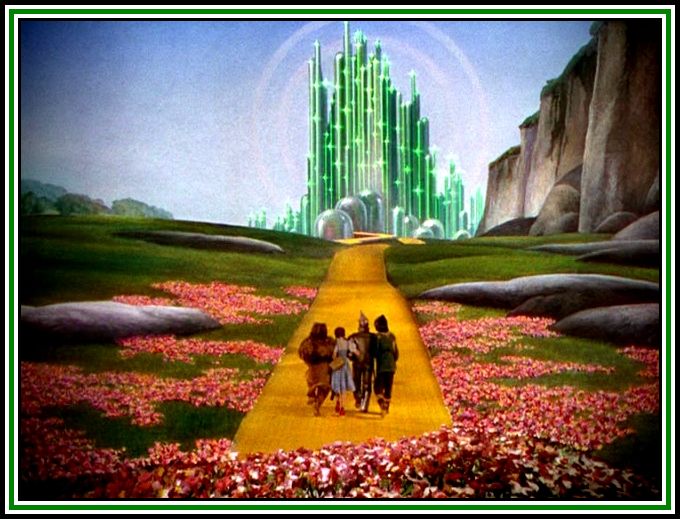
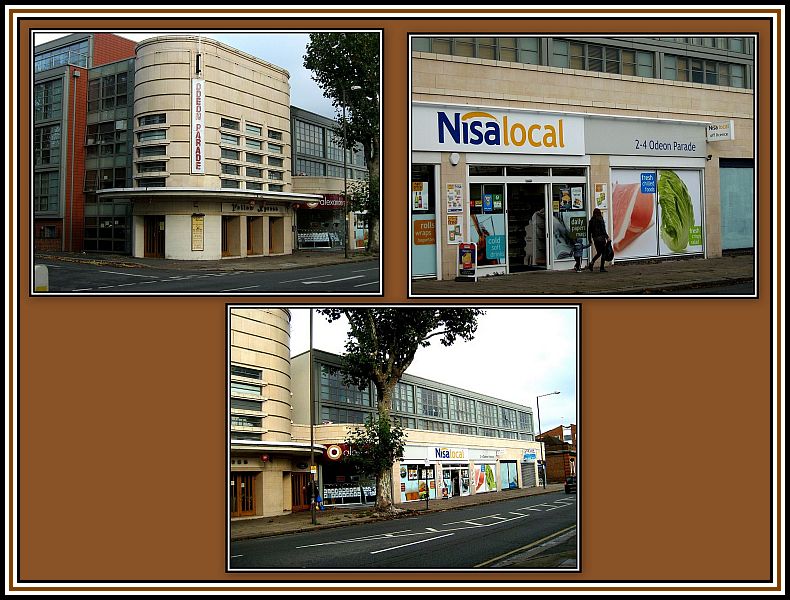
Wonderful Thank you,
I grew up in Isleworth and it was so good to come across this site which brought back so many memories.
The H prefix on London buses, ie H37 originally
stood for Hopper as when these routes were
introduced in the 1980’s they were for
shortened bus routes. The original 37 bus
route went from Hounslow to Peckham but
when the larger one man buses were introduced
these couldn’t negotiate the diversion along
Loring Road to avoid the low bridge at St Johns Rd.
LT shortened to route as far as Richmond with Hoppa
Buses.
Many thanks for passing on this explanation.
Charles
I probably think this is real but It might not be